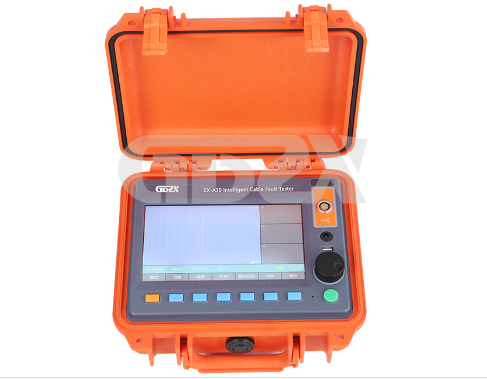NEWSnews
Redefining Cable Fault Location: The ZX-A30 Intelligent Test System
Introduction:
For technicians battling cable faults, speed, accuracy, and field practicality are paramount. Traditional methods often involve cumbersome equipment, complex manual interpretation, and limited data management. The ZX-A30 Intelligent Cable Fault Test System emerges as a significant technological leap, integrating advanced computing, communication, and testing methodologies into a remarkably portable and powerful platform. Let's examine how it compares to conventional approaches.
Core Advantages & Technological Integration:
Moving beyond standalone instruments requiring intricate coordination, the ZX-A30 is built on an embedded industrial computer running Windows XP. This foundation hosts sophisticated cable fault testing and data management software, centralizing the entire diagnostic workflow. The 12.1-inch touchscreen interface (usable with pen or mouse) offers intuitive control and clear waveform visualization even outdoors, powered by a practical lithium battery.
Key Innovations & Comparative Benefits:
1.Intelligent Multi-Pulse Technology & Automation:
Contrast: Older methods often rely on single-pulse Low Voltage (LV) or cumbersome High Voltage (HV) flashover techniques, requiring manual waveform analysis and distance calculation, prone to user error and oscillation interference.
ZX-A30 Advantage: Its unique Multiple Pulse Generator (MPG) (only 5kg) allows three testing methods (LV, HV Flashover, Multiple Pulse) without reconnecting cables. A single discharge captures 10 low-voltage pulse waveforms, drastically reducing noise. The system automatically identifies the fault type, locates the point, and displays the distance with three on-screen display zones. Dual-positioning (auto/manual) and a double vernier (0.15m resolution) ensure high precision. Locating error is ±0.2m, significantly reducing guesswork and excavation time.
2.Advanced Sampling & Communication:
Contrast: Legacy testers might have fixed or limited sampling rates, struggling with different cable lengths and types. Remote support was nonexistent.
ZX-A30 Advantage: Utilizes USB communication for stable signal acquisition. The host automatically selects from five sampling frequencies (6.25MHz to 100MHz) with adaptive pulse width, optimizing accuracy for any cable length and minimizing rough measurement errors (±1% system error). Integration of WIFI and 3G communication enables real-time remote expert assistance. Technicians can receive guidance via Android software, a game-changer for complex field scenarios.
3.Integrated High Voltage & Lightweight Design:
Contrast: Conventional HV surge testing requires a heavy transformer (often 65kg+) and a separate operating box, demanding multiple personnel and vehicles for transport and setup.
ZX-A30 Advantage: Employs a brand-new 28kg Integral High Voltage Surge Generator, replacing the traditional 65kg+ setup. This offers three HV discharge modes in a package that's lighter, more versatile, and achieves domestic leading levels of integration. The host itself is only 6.2kg (180x300x400mm), enhancing true portability.
4.Comprehensive Data Management & Diagnostics:
Contrast: Waveform storage was often limited or offline; generating reports and managing cable history was manual and disjointed.
ZX-A30 Advantage: Features 8GB storage for vast waveform libraries and wiring layouts for easy field comparison. It automatically generates and prints test reports. The integrated Cable Management System is crucial for maintenance, storing cable routes, distribution maps, burial details, fault history, reasons, and test records – enabling predictive maintenance and precise historical fault location.
5.Enhanced Fault Location & Tracing:
Contrast: Pinpointing often relied heavily on separate, sometimes less accurate, acoustic or magnetic methods after pre-location.
ZX-A30 Advantage: The included Precise Locator directly displays distance-to-fault, utilizing innovative squelch technology (a domestic first) for faster, more accurate pinpointing, minimizing outage time and damage. The integrated Cable Router Tracer (15kHz, ≥100W output) efficiently maps buried routes and depths.
Technical Capabilities Summary:
1.Fault Types: Open, short, low-resistance, high-resistance leakage, high-resistance flashover (up to 35kV cables).
2.Cable Types: Power, railway signal, streetlight, airport signal.
3.Range: ≥ 60 km.
4.Accuracy: Locating error ±0.2m, System error ≤ ±1%.
5.Environment: -20°C to +40°C, ≤80% RH.
6.Power: AC 220V±10% (≤15W) or DC 12V/7AH (≤20W, ~6hrs runtime).
7.MPG: Output ≤ 40kV.
Conclusion:
The ZX-A30 Intelligent Cable Fault Test System represents a paradigm shift for field technicians. By integrating a powerful industrial computer, revolutionary multi-pulse technology, lightweight HV generation, robust communication (3G/WIFI), and sophisticated cable data management into a single, portable platform, it addresses the core limitations of traditional test sets. It dramatically enhances speed, accuracy (±0.2m), ease-of-use, and diagnostic capabilities while significantly reducing physical burden (28kg HV vs. 65kg+). For technicians seeking to minimize downtime, optimize resources, and leverage intelligent diagnostics, the ZX-A30 sets a new standard in cable fault location technology. It's not just an instrument; it's a comprehensive, connected, and highly intelligent fault-finding platform.
GDZX is a manufacturer of power detection equipment, offering a diverse range of products with comprehensive models and providing professional technical support. Contact us at +86-27-6552607 or +86-17396104357.Website: http://en.gdzxdl.com/






















